Galatians | Ephesians |Romans | Apostolic Church | Modern Takes | Bible Interpretation
[Note: Our Amazon links work in Canada, US and Great Britain to your local stores. Besides that, many Kindle books can be downloaded world-wide.]
The Book of Romans
Lessons | Resources used by Authors | Ellen White Resources | Bible versions | Practical Life
The Adult Bible Study Guide for the fourth quarter of 2017 is focused on the Book of Romans. (Also see other previous studies all the way back to the 1800’s.)
You may download the full lesson quarterly from Amazon in Kindle format. Just for interest’s sake, you might want to compare the current lessons to earlier ones in the 1900’s.
The companion book for the lesson by George R. Knight, Romans: Salvation for All (Bible Bookshelf Series) originally only available in paperback is now available in Kindle format. Thanks to Eunice for letting us know in a comment on this page, since the paperback and Kindle version are listed as two separate books, and we would not have noticed otherwise.
For a very readable alternative to Knight’s book, we also recommend Wiersbe’s Be Right. Of course, it does not follow the sequence of this lesson quarterly, but the actual letter Paul wrote to the church at Rome. Many of Knight’s other books are also very much focused on the message of Paul to the Romans, and they would make excellent background reading for this quarter.
Resources Referenced by the Lesson Authors
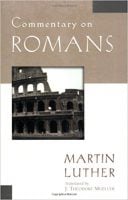 The classic Martin Luther’s Commentary on Romans is most frequently referenced by the lesson author. (You’ll find several versions of the Commentary at this link.) And we can read for ourselves just what lay at the root of the Protestant Reformation that pulled the Western world out of the Dark Ages. (Hint: Read the comments by other customers to find the best edition.) The Mueller translation referenced by the author (see at right) links to the Paperback version, since a Kindle version doesn’t seem to be available. But if you prefer paperback, your shipping is free if you just add a few more items to your cart and you live in the USA.
The classic Martin Luther’s Commentary on Romans is most frequently referenced by the lesson author. (You’ll find several versions of the Commentary at this link.) And we can read for ourselves just what lay at the root of the Protestant Reformation that pulled the Western world out of the Dark Ages. (Hint: Read the comments by other customers to find the best edition.) The Mueller translation referenced by the author (see at right) links to the Paperback version, since a Kindle version doesn’t seem to be available. But if you prefer paperback, your shipping is free if you just add a few more items to your cart and you live in the USA.
Handbook of Seventh-day Adventist Theology, Commentary Reference Series, Volume 12. Ed. Raoul Dederen. Published in 2000, it is rare, and it is difficult to find a copy for less than $US 80.00. (Best price on Amazon.) But you can read it for free online with a membership at Scribd.com.
A Modest Proposal and Other Satires, by Jonathan Swift is mentioned by the author but doesn’t necessarily contribute to the lesson study.
Other Commentaries on Romans
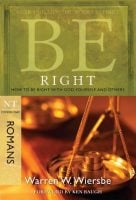 On Amazon, the book, Be Right by Warren W Wiersbe caught my (Inge Anderson’s) attention, and I’ve read several crucial chapters to determine his approach, and I’m pleased with what I’ve read so far. The foreword by Ken Baugh will help me teach the first lesson – a little differently than presented by the lesson author.
On Amazon, the book, Be Right by Warren W Wiersbe caught my (Inge Anderson’s) attention, and I’ve read several crucial chapters to determine his approach, and I’m pleased with what I’ve read so far. The foreword by Ken Baugh will help me teach the first lesson – a little differently than presented by the lesson author.
Wiersbe makes the same necessary distinction between Sin and sins as George Knight does, and he clarified quite effectively what Paul means by “the law” in Romans 7. He shows that being in Christ results in a life in harmony with the Law. He also demonstrates just what makes a “legalist,” providing each of us with food for thought.  (Wiersbe is an evangelical pastor and author who has written a series of very readable commentaries. )
(Wiersbe is an evangelical pastor and author who has written a series of very readable commentaries. )
John Brunt’s Redemption in Romans was a companion book to a previous Adult Bible Study Guide on Romans. You might want to check out his perspective as well.
General Resources for Apostolic Church
Helpful Ellen White Books Referenced
Note: You can read all of these for free at egwwritings.org. You can also get the same content as an Android or iPhone app. We use the site and app all the time for reference. But we do have the real paper books as well, and they are well marked. However, now that our eye sight is not as good as it used to be, we have learned to appreciate the Kindle versions which we can read on our phone or tablet – even in bed. 🙂 The free Kindle app or a regular tablet or Kindle Reader will keep your place in multiple books, so you can actually read them through, even if you read several books at more or less the same time, as I generally do. You can generally find both the Kindle and paper versions at the links below:
For any studies of the apostolic church, Ellen G. White’s classic, 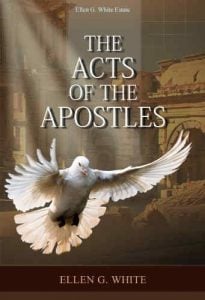
Acts of the Apostles provides valuable context as well as specific insight. It is the most frequently referenced and most helpful Ellen White book for the fourth quarter of 2017. This may be a good time to read the whole book through and to be inspired with what God can do with a small group of dedicated followers. (You’ll find lots of options at Amazon.)
If you have previously read the original Acts of the Apostles you may enjoy the freshness of the modern language version, Unlikely Leaders. And if English is not your first language, you will definitely find this less challenging, because it uses modern vocabulary. It is a somewhat shortened version, due to some of the Bible references being left out. If you want lots of Bible texts to corroborate what Ellen White wrote, be sure to get the original version of Acts of the Apostles. And remember that the best version of any good book is the version you’ll actually read and enjoy. 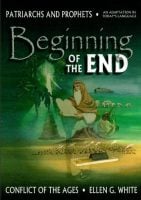
Patriarchs and Prophets The story of beginnings – from the entrance of sin in heaven to the end of the patriarchal age. If you haven’t read this before, we recommend you do, and you’ll find a richness added to your Bible reading that you didn’t experience before. For a fresh, easier-to-read version, we suggest The Beginning of the End. It’s a bit shorter and uses updated language, making it easier to read.
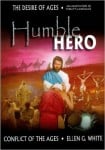 Desire of Ages, by Ellen White, is probably the most widely read and translated biography of Christ. If you’ve read it before, you know it helps to bring the story of Christ to life, and it speaks to the heart. (Many options at Amazon.) Whether or not English is your second language, you may want to take a look at the adapted version, Humble Hero. Published in fresh, modern language, it is easier to read and often gives fresh insights. Having read the original version a number of times, I enjoy this adaptation and find it true to the original.
Desire of Ages, by Ellen White, is probably the most widely read and translated biography of Christ. If you’ve read it before, you know it helps to bring the story of Christ to life, and it speaks to the heart. (Many options at Amazon.) Whether or not English is your second language, you may want to take a look at the adapted version, Humble Hero. Published in fresh, modern language, it is easier to read and often gives fresh insights. Having read the original version a number of times, I enjoy this adaptation and find it true to the original.
Advent Review and Sabbath Herald, Sep 3, 1889. Click on the link to read a scanned version of the original magazine. The first article in the magazine is a message by Ellen White in which she deals with justification by faith, among other things. You may find yourself distracted by a lot of interesting little historical details that help provide atmosphere for the original articles.
Christ’s Object Lessons. If you’ve read this classic commentary on the parables of Christ, you already love it as we do. If not, a real spiritual feast awaits you. The link will lead you to several Kindle and paper versions, including some with lots of illustration, others as collections with Steps to Christ and Thoughts from the Mount of Blessings.
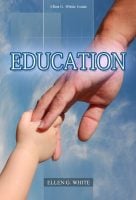 Education This book is so outstanding on the subject of a real education that it was plagiarized by a minister of education in one of the eastern bloc countries and published there many decades ago. I studied it as a text book in a “Philosophy of Education” class in college, and there is none better. Some of the passages I memorized still ring in my mind, such as this from the very first chapter: “True education … is the harmonious development of the physical, the mental, and the spiritual powers. It prepares the student for the joy of service in this world and for the higher joy of wider service in the world to come.” (Okay, I confess I just looked it up in my app to get it right. The paper book is on the shelf, with this passages, as well as many others, highlighted.)
Education This book is so outstanding on the subject of a real education that it was plagiarized by a minister of education in one of the eastern bloc countries and published there many decades ago. I studied it as a text book in a “Philosophy of Education” class in college, and there is none better. Some of the passages I memorized still ring in my mind, such as this from the very first chapter: “True education … is the harmonious development of the physical, the mental, and the spiritual powers. It prepares the student for the joy of service in this world and for the higher joy of wider service in the world to come.” (Okay, I confess I just looked it up in my app to get it right. The paper book is on the shelf, with this passages, as well as many others, highlighted.)
Evangelism. I confess I don’t usually like compilations of Ellen White quotes, but this one is an exception. It is a practical guide to how to share the “Good News,” particularly aimed at evangelists, but also useful in local churches and for private study.
Faith and Works. A compilation, with good things in it, including some great statements on the relation of faith to works, but a bit heavy on the “works” end. Like I said, I don’t like compilations much because it’s too easy to skew the author’s intent into what the editor would like to say. 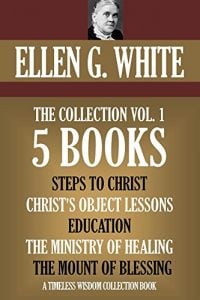 If you haven’t read the whole Conflict of the Ages, Steps to Christ, Christ’s Object Lessons, Ministry of Healing and Thoughts from the Mount of Blessings, read them first before this one – just so you know what the balance should be.
If you haven’t read the whole Conflict of the Ages, Steps to Christ, Christ’s Object Lessons, Ministry of Healing and Thoughts from the Mount of Blessings, read them first before this one – just so you know what the balance should be.
Ministry of Healing. Lots of options for this book, which is one of the books centered on the life of Christ – this one being on His healing ministry and its application to healers in today’s world. It’s also part of the Timeless Collection, which is a real bargain with the full text of 5 related books. When introducing folks to Ellen White, these are the books I recommend first along with the Conflict of the Ages series.
SDA Bible Commentary, Vol. 6. You could pick up the whole book (or the full set, for that matter) at the link I provided, but, realistically, the author refers only to the Ellen White Comments, and you can pick those up for less than US$1.00. (Alternately, you can pick up the EGW app or go to egwwritings.org. It’s not the kind of book to read from beginning to end, like the others recommended here.
The SDA Encyclopedia. Good price for the SDA Encyclopedia on Amazon. That said, I don’t think we got that much worth out of ours. I wouldn’t buy it again, but if you’re a bibliophile, you might. 😉
Selected Messages, Book 1. This is a great little compilation, first published 1958. (At least that’s the date on ours.) I think the editor of this one got the balance just right. This compilation is Christ-centered.
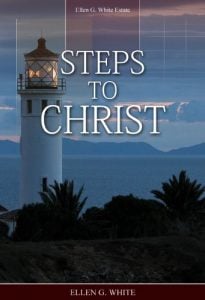 Steps to Christ. My genuine leather-bound copy (mine is black) has been read and underlined again and again – as was the bright red pocket hardback copy before it. And now I’m high-lighting my Kindle version. It never gets old but refreshes again and again. If you don’t own this book, you need to get it and read it for yourself – not just online. (Best to get one you can put in your pocket, purse or backpack.) I remember when we gave this book to a Christian woman of another denomination who had never heard of Ellen White. She read it and loved it so much that she exclaimed, “This woman must have been inspired!” (You think?) The lesson author references this book once this quarter, I believe.
Steps to Christ. My genuine leather-bound copy (mine is black) has been read and underlined again and again – as was the bright red pocket hardback copy before it. And now I’m high-lighting my Kindle version. It never gets old but refreshes again and again. If you don’t own this book, you need to get it and read it for yourself – not just online. (Best to get one you can put in your pocket, purse or backpack.) I remember when we gave this book to a Christian woman of another denomination who had never heard of Ellen White. She read it and loved it so much that she exclaimed, “This woman must have been inspired!” (You think?) The lesson author references this book once this quarter, I believe.
Testimonies for the Church, Vol. 1., begins with a biographical sketch and Ellen White’s first vision in 1844 and covers written testimonies from the year 1855 to 1868.
Read the Testimonies after you’ve read the Conflict of the Ages and the Timeless Collection, remembering that these volumes are collections of individual testimonies given to specific people at a specific time and place. They may or may not apply to you and me in the same way. (For instance, to “eat less” applies to many, but others should “eat more.”) They are interesting for historical reasons, and they contain many gems of truth that are timeless. After reading the Conflict of the Ages and the Timeless Collection, reading the series of Testimonies, one after the other can be a great historical/spiritual journey. It is important for understanding the history of our church.
Testimonies for the Church, Vol 2 contains testimonies written to individuals and the church at large in the years 1868 to 1871.
Testimonies for the Church, Vol. 3 includes testimonies written in the years 1876 to 1881.
Testimonies for the Church, Vol 5 includes testimonies written in the years 1882 to 1889.
Testimonies to Ministers and Gospel Workers A compilation of testimonies specifically aimed at ministers and other gospel workers. This links to a nice edition of this volume.
Thoughts from the Mount of Blessings. Along with Steps to Christ, this is one of my most re-read books. The very first paragraphs transport the reader to a mountainside in Judea where Christ is sharing the principles of His Kingdom – the Kingdom that He taught us to ask for in prayer: “Thy Kingdom come on earth, as it is in heaven.” He taught how to live in His Kingdom here, and I remember one of my favorite passages that is so true: “Human nature is ever struggling for expression, read for contesst; but he who learns of Christ is emptied of self, of pride, of love of supremacy, and there is silence in the soul. … It is the love of self that destroys our peace. While self is all alive, we stand ready continually to guard it from mortification and insult; but when we are dead, and our life is hid with Christ in God, we shall not take neglects or slights to heart. We shall be deaf to reproach and blind to scorn and insult.” (pp. 15 – 16) “Silence in the soul.” Can you hear it?
Bible Translations & Interpretation
In the Bible Versions section of the quarterly, there’s a reference to the CJB Bible /Complete Jewish Bible by David H. Stern. Copyright© 1998. For those of us interested in different Bible versions, this could prove interesting. Most of us may not want to buy the leather-bound Complete Jewish Bible, but the Kindle version is considerably more affordable. The Old Testament presents the books in the Hebrew order of the Jewish Tanakh. It may help to clarify misunderstandings by recognizing Jewish historical and cultural backgrounds. It also includes a Jewish New Testament. The Messianic Jewish Net also offers this Bible version in a “Study Bible” format which is particularly designed to illuminate the Jewish background of the text.
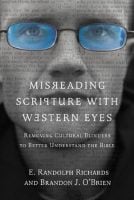 And that reminds me of a fascinating book I have been reading: Misreading Scripture with Western Eyes: Removing Cultural Blinders to Better Understand the Bible, by co-authors
And that reminds me of a fascinating book I have been reading: Misreading Scripture with Western Eyes: Removing Cultural Blinders to Better Understand the Bible, by co-authors
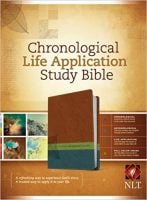 If you’re not familiar with the New Living Translation (NLT) of the Bible, we invite you to check it out. We have the NLT Chronological Life Applications Study Bible in Duotone Imitation Leather (very nice, but ours is brown and tan), and to read it through together, we also got the Kindle version (much less expensive). The Kindle version works very well on a tablet, but is also okay on Samsung Note 4 phone. We’ve read it through once as a family and found that it is remarkably accurate, even though we disagree with a few translated phrases. But then the KJV isn’t error-free either. See more details on our New Living Translation of the Bible page.
If you’re not familiar with the New Living Translation (NLT) of the Bible, we invite you to check it out. We have the NLT Chronological Life Applications Study Bible in Duotone Imitation Leather (very nice, but ours is brown and tan), and to read it through together, we also got the Kindle version (much less expensive). The Kindle version works very well on a tablet, but is also okay on Samsung Note 4 phone. We’ve read it through once as a family and found that it is remarkably accurate, even though we disagree with a few translated phrases. But then the KJV isn’t error-free either. See more details on our New Living Translation of the Bible page.
I have to chuckle when some saintly old folks in my Sabbath School class apologize for “only” having a “new version” of the Bible when asked to read some texts aloud. Often the fresh, modern translation can help us see new things in familiar texts.
Now For Some Practical Life Applications of Romans
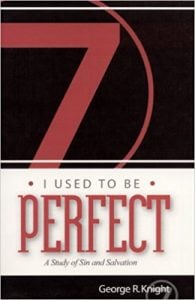 In I Used to be Perfect: A Study of Sin and Salvation George R. Knight tackles the issue of “sin” head-on, doing his best to get the reader to think beyond the pat answer of “transgression of the law.” I think it should be a must-read for every Seventh-day Adventist. Written in engaging and readable, if provocative, way, Knight weaves his own struggle with legalism and perfectionism into his teaching. His self-deprecating sense of humor made me smile many times. He clearly demonstrates Paul’s teaching of being saved by grace through faith, and that makes this a very helpful book for understanding Romans and Galatians.
In I Used to be Perfect: A Study of Sin and Salvation George R. Knight tackles the issue of “sin” head-on, doing his best to get the reader to think beyond the pat answer of “transgression of the law.” I think it should be a must-read for every Seventh-day Adventist. Written in engaging and readable, if provocative, way, Knight weaves his own struggle with legalism and perfectionism into his teaching. His self-deprecating sense of humor made me smile many times. He clearly demonstrates Paul’s teaching of being saved by grace through faith, and that makes this a very helpful book for understanding Romans and Galatians.
Understanding Paul’s teaching brought light and freedom to Martin Luther and George Knight, and if you’re struggling to be perfect to be saved, the understanding clearly laid out in this book will bring light and freedom to you too. Highly recommended. We’ve linked to the second edition, which includes study questions at the end of each chapter. (In the preview on Amazon, you’l see that the title of the first chapter is “SIN Is Love” and the first sentence, “Eating cheese is not sin.” That’s what I call provocative. But read on to follow his reasoning. For instance, are you clear on the difference between SIN and “sins”?)
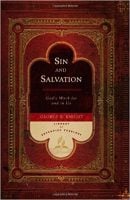 I Used to Be Perfect encapsulates much of George R. Knight’s teaching that you’ll also find in other, more formal books, such as Sin and Salvation: God’s Work for Us and In Us, replete with end notes, Scripture index and index of names and topics. Knight explores justification, sanctification, perfection, sinlessness and how they are related to each other. .Converted from agnosticism to Christianity more than 40 years ago, Knight long wrestled with what it means to be saved, what God can do for us and in us. This book in many ways is the result of that personal search. It is also helpful in understanding how to interpret the biblical text. (If you’re a scholar, this one’s for you. Only available in hardcover.)
I Used to Be Perfect encapsulates much of George R. Knight’s teaching that you’ll also find in other, more formal books, such as Sin and Salvation: God’s Work for Us and In Us, replete with end notes, Scripture index and index of names and topics. Knight explores justification, sanctification, perfection, sinlessness and how they are related to each other. .Converted from agnosticism to Christianity more than 40 years ago, Knight long wrestled with what it means to be saved, what God can do for us and in us. This book in many ways is the result of that personal search. It is also helpful in understanding how to interpret the biblical text. (If you’re a scholar, this one’s for you. Only available in hardcover.)
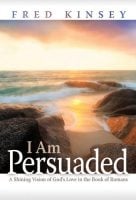 I am Persuaded. Fred Kinsey says, “Before Romans I had a wonderful sense of right and wrong, of dos and don’ts. But I never experienced any of the joy or hope that a Christian ought to have. Before Romans I might have looked good on the outside, but inside I knew I was lost. Then I read the book of Romans, and a flood of light poured into my life.”
I am Persuaded. Fred Kinsey says, “Before Romans I had a wonderful sense of right and wrong, of dos and don’ts. But I never experienced any of the joy or hope that a Christian ought to have. Before Romans I might have looked good on the outside, but inside I knew I was lost. Then I read the book of Romans, and a flood of light poured into my life.”
A practical application of the book of Romans in a great little book.
|
Most of the resources below are available in electronic format, readable with a Kindle reader. If you don’t have a genuine Kindle reader, you can download the Amazon.com free reader for the PC, or the FREE app for almost any mobile devices. |
Previous Studies in the Book of Romans
In the third quarter of 2010, we had a series of studies on Redemption in Romans similar to the first quarter of 1980. (The titles in those two sets of lessons are very similar, but we haven’t checked whether the content is identical. If you check, please lest us know in a comment.)
In the fourth quarter of 1990 our quarterly studies were under the title of The Letter to the Romans (PDF file). And the lessons for the first quarter of 1959 were just entitled, Romans. Likewise for the fourth quarter of 1913 and the first quarter and second quarter of 1914 (That was 39 lessons on the Book of Romans!), the fourth quarter of 1930 and the second quarter of 1931.
Letter to the Galatians
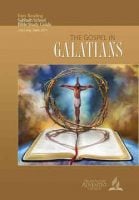 The Adult Bible Study Guide for the fourth quarter of 2011 and the third quarter of 2017 was focused on The Gospel in Galatians, by Carl P. Cosaert. Same study guide, different cover. You may download the full lesson 2017 quarterly from Amazon in Kindle format. (If you don’t have a Kindle, you can download the free reader for the PC, or the FREE app for mobile devices by clicking on this link.)
The Adult Bible Study Guide for the fourth quarter of 2011 and the third quarter of 2017 was focused on The Gospel in Galatians, by Carl P. Cosaert. Same study guide, different cover. You may download the full lesson 2017 quarterly from Amazon in Kindle format. (If you don’t have a Kindle, you can download the free reader for the PC, or the FREE app for mobile devices by clicking on this link.)
 Studying Paul’s letter to the Galatians once more is a good thing because there’s always more to learn, and the lessons in Ephesians are especially important for our time. Really delving into God’s Word is always new and interesting. And if you will avail yourself of the historical and experiential insight of George Knight in Gospels in Conflict, I guarantee you will not be bored and will learn a thing or two. I (Inge Anderson) am enjoying the book myself, and it has proved valuable in preparing for teaching. I invite you to do the same. You can read the book on whatever device you are using to read this (just download the reader). I enjoy keeping books on my smart phone, because that way I can use spare minutes to good advantage.
Studying Paul’s letter to the Galatians once more is a good thing because there’s always more to learn, and the lessons in Ephesians are especially important for our time. Really delving into God’s Word is always new and interesting. And if you will avail yourself of the historical and experiential insight of George Knight in Gospels in Conflict, I guarantee you will not be bored and will learn a thing or two. I (Inge Anderson) am enjoying the book myself, and it has proved valuable in preparing for teaching. I invite you to do the same. You can read the book on whatever device you are using to read this (just download the reader). I enjoy keeping books on my smart phone, because that way I can use spare minutes to good advantage.
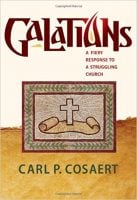 Ellen White Notes on The Gospel In Galatian, by Pacific Press.
Ellen White Notes on The Gospel In Galatian, by Pacific Press. 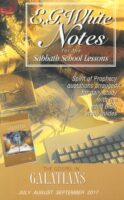 Quotations specifically chosen to accompany the Adult Bible Study Guide on The Gospel in Galatians.
Quotations specifically chosen to accompany the Adult Bible Study Guide on The Gospel in Galatians.
You may want to compare Carl Cosaert’s Galatians: A Fiery Response to a Struggling Church(right) with George Knight’s Gospels in Conflict. (above) Cosaert’s book is currently bargain-priced at Amazon.com.
Letter to the Ephesians
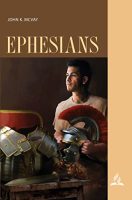 The Adult Bible Study Guide for the third quarter of 2023 focuses on Ephesians . You may download the full lesson quarterly for studying Ephesians in Kindle format from Amazon. The study guide has been prepared by Tom K. McVay, Ph.D., president and professor of religion at Walla Walla University in College Place, Washington, USA, where he has served since 2006
The Adult Bible Study Guide for the third quarter of 2023 focuses on Ephesians . You may download the full lesson quarterly for studying Ephesians in Kindle format from Amazon. The study guide has been prepared by Tom K. McVay, Ph.D., president and professor of religion at Walla Walla University in College Place, Washington, USA, where he has served since 2006
John K. McVay also wrote the Bible Bookshelf book for this quarter, entitled, Ephesians . Clicking on the link or the image on the right above will take you to an Amazon.com page where you can purchase a paper copy or the Kindle version.
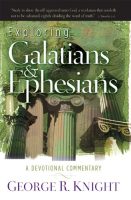 The Ellen White companion book to Ephesians is also available in Kindle format from Amazon.com.
The Ellen White companion book to Ephesians is also available in Kindle format from Amazon.com.
If you like to have your thinking challenged and gain new insights, George Knight’s book is a good option: Exploring Galatians & Ephesians. (I am enjoying it again for the 2023 third quarter.)
This page was prepared by Inge Anderson, publisher of Sabbath School Net.

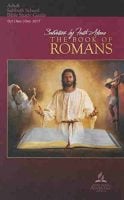
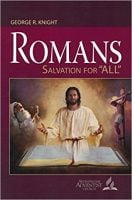
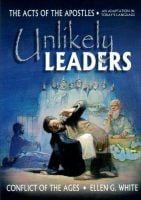
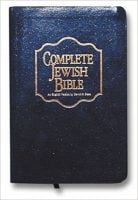
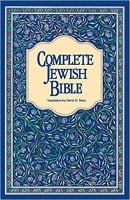
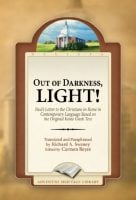
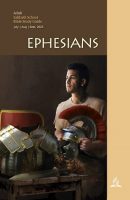
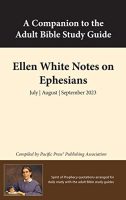
I am currently reading Carl Coseart’s book. OK, I have only seriously read the first 5 pages and have done a quick scan of the rest of the book. I like what I see and should be able to provide a more detailed review in a couple of weeks time.
And I’m reading George Knight’s book on Galatians and am really enjoying it. He’s helped me untie a few knots. Now it would be nice if we could just trade books back and forth once in a while. 🙂
George Knight’s book “Romans: Salvation for all” is also available at Amazon now on Kindle. It is available on Nook at Barnes and Noble.
Thank you, Eunice!
The Medieval church banned Martin Luther’s book. Now one of our Conferences has banned George Knight’s books. We did not learn much from the Reformation!
Yes, it seems so. I understand that his latest book, Adventist Authority wars, Ordination and the Roman Catholic Temptation, especially aroused the anger of conference leadership.
In that book, Knight proposes that other issues are but symptoms and that the real issue is the push towards a hierarchical form of governance, with each level of governance having authority over the “lower” level – i.e. conferences have authority over churches, unions have authority over conferences, and the divisions/GC have authority over unions. That would also put the GC President in the position of the pope. (Knight doesn’t actually come out and say that, though.)
By contrast, Jesus said, “It shall not be so among you.” (Matthew 20:25-27) He taught us that we are to *serve* one another, not rule over each other. Consequently the organization of the Adventist church was originally designed to be non-hierarchical, with churches voluntarily associating in conferences, which voluntarily associated in unions, with the GC facilitating this association. The authority was to rest in the local church body, with the vote of members subject to the Holy Spirit expressing the mind of the Spirit. In other words, our organization was designed to the Spirit-led. (In this book, Knight briefly explores the history of our organization, but my summary is my own understanding. As church historian, Knight earlier wrote the book, Organizing to Beat the Devil: The Development of Adventist Church Structure, Adventist heritage series. The name of George Knight appears to be anathema among all in our church who believe in a hierarchical church organization.
However, it seems that a lack of faith has repeatedly led to a giving in to “the Roman Catholic temptation,” with a resultant consolidation of power at the top. Ellen White strongly warned against this. But leaders, fearing the inroads of false teachings saw the solution as more control and thus created policies after policies to grasp this control. (Our GC Policies Manual now has over 700 pages.) But Ellen White wrote this:
“The church may pass resolution upon resolution to put down disagreement of opinions, but we cannot force the mind and will, and thus root out disagreement.” Ellen G. White, (Manuscript 24, 1892)
Unity will come only through the Holy Spirit. And He will cause us to regard one another as equals. As Ellen White also said,
“The secret of unity is found in the equality of believers in Christ. The reason for all division, discord, and difference is found in separation from Christ.” (1 Selected Messages, p. 259)
Come to think of it, that message is not far from the central message of the book of Romans, is it?
No Dorothea, our church needs organization. Yes, it also needs each of its members to find unity in union with Christ. George Knight is not infallable, he has said somethings that maybe are not correct, that is why we look to Christ and not man. Our Church does not have a Pope we stand on 7 pillars of our faith that are non-negotiable 1. Sabbath 2.Spirit of Prophecy. 3. Sancatuary message and Millennium. 4. State of the dead 5. Three Angles Message 6. Christ righteousness 7. Gods law of love(10 commandments). May God bless you.
Great advice, follow the Spirit willingly.
Why are so many of the questions and content in the three lessons (this one, Redemption in 2010 and the one in the 1980s) so similar/identical?
Maybe because they’re all on the same subject. 😉
Other sets of lessons have been repeated in the past as well. If a lesson quarterly does a good job of covering the subject, and the subject needs to be studied more, that seems like a good argument for repeating the set of lessons.
If you still remember the last set, you will be pleased to discover that the companion books are different. But then any of George Knight’s books are different from anyone else’s. 😉
[Just so you know, we have nothing to do with writing the lessons. We just publish them on the internet by permission.]